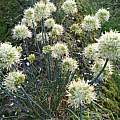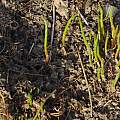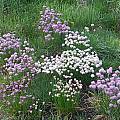This page compiles all the information and photos of the Allium taxa, cultivars, and hybrids we currently have on the PBS wiki. The Allium index gives information about the genus and includes tables of species and hybrids and cultivars.
Page 1: A. Globemaster... Page 2: A. atropurpureum... Page 3: A. carmeli... Page 4: A. decipiens... Page 5: A. guttatum... Page 6: A. karataviense... Page 7: A. membranaceum... Page 8: A. paradoxum... Page 10: A. serra... Page 11: A. tardiflorum... Page 12: A. vineale...
Allium regelii Trautv. (syn. Allium cupuliferum var. regelii (Trautv.) Regel, Allium yatei Aitch. & Baker) is one of the most sought Alliums in the world, yet appears to be a poor seed producer. It is native from northern Iran to central Asia. It is the only species to produce two-tiered blooms, along with the hybrid Allium angulosum L. Photo by Wietse Mellema, showing a second umbel budding from a scape coming up from the lower umbel.
Allium robustum Kar. & Kit. - a little known (thus expensive) species, perhaps related to A. atropurpureum Waldst. & Kit. In A. robustum the tight, domed heads are strikingly hued cherry red, noticeably dark wine red in bud, but opening to a lively cherry red when open. The central ovaries are dark grayish. Blooms in June, on stems that varied from 18"-24" (45-60 cm). Photo by Mark McDonough.
Allium roseum L. is a rather uncommon Mediterranean species with pink flowers. It produces many bulbils and bulblets in one season which makes it invasive in some places. Growers in Mediterranean climates beware! This bulb is mass produced by the Dutch and can easily be obtained through regular bulb catalogs or the internet. Photo 1 was taken in habitat by Angelo Porcelli. Photos 2-4 were taken by Nhu Nguyen growing in a Mediterranean bed in Berkeley, California. Notice the numerous bulbils on the inflorescence.
Last picture shows a plant in Martin Bohnet's temperate garden, where the usually also pinkish plants in one year went totally white, indicating a climate influence on coloration.
Allium rothii Zucc. is a species from Israel. Plants have upright umbels and falcate leaves. The petals are white with a green stripe, contrasting with the deep maroon anthers and blackish ovary. Photos of wild plants by Gideon Pisanty.
Allium rotundum L., syn. Allium scorodoprasum ssp. rotundum (L.) Stearn, is an Eurasian and North African species also naturalized in the United States (Michigan), the Canary Islands and South Australia. It grows to 18-24" (45-60 cm) tall, is slender of growth, and has tight oblong knobs of dark wine red-purple flowers. The first photo taken by Mark McDonough who wrote: "One of my favorites and easy to grow." The second photo from Mary Sue Ittner.
Photos by Rimmer de Vries, who comments 'I had two collections by Kirk Vickory in my garden a short 18” form and a taller 24” form they may have gotten mixed up. These made much smaller 1-1-1/2” heads in sand in Michigan, here in Kentucky heat and red clay they make large 2-1/2-3” heads'
Allium rubens Spreng. is a quiet, unassuming species from Central Asia. It has very narrow foliage, and little, few-flowered semi-nodding clusters of light pink bells. The roots and bulb base are also reddish pink color. It is one of the few "ever blooming" species, throwing up modest blooms all summer long. The first four photos from iNaturalist were taken by Petr Kosachev in Russia in August and shared under a CC BY-NC license. The last image below is a drawing by Mark McDonough.
Allium sanbornii Alph.Wood is a large onion restricted to the Sierra Nevada and southern Cascade foothills of California. It is only found on serpentine outcrops. Photos by Nhu Nguyen. Seeds sprout readily and this species is actually one of the easier California onions to grow. It is one of the latest blooming species (around July) when most other native bulbs have already gone into dormancy. It requires a very dry summer dormancy period. The photos below were taken by Nhu Nguyen. Photos 1-3 were of plants growing at the Tilden Botanic Garden.
The photos below were taken by Nhu Nguyen of a white form of this species.
Allium sativum L., is cultivated garlic. Due to a long history of cultivation and selection its origin is unknown; it may have first appeared in Asia as a descendent of Allium longicuspis Regel. Photos Janos Agoston.
Allium saxatile M.Bieb is a Eurasian species of Allium native to European Russia, Belarus, the Caucasus, and the Altai Krai region in Siberia. Photos of different color forms grown and photographed by Wietse Mellema in his bulb farm in the Netherlands.
Allium schmitzii Cout. is endemic to Portugal, growing on river banks and in rock crevices. Closely related to chives, or A. schoenoprasum L. (see above), with similar narrow hollow leaves. The upright, rather open umbels of starry pale pink flowers are unlike the dense, oblong bloom heads of chives, distinguishing itself from that species. Photo by John Lonsdale.
Allium schoenoprasum L. is the species known as chives. It has a wide distribution in the temperate Northern Hemisphere. The range of chive forms provides a constant source of interest for this single species. The first photo by Andrey Dedov is of a mountain growing form from the Altai Region in Central Asia. Photos 2-5 by David Pilling show a single flower which despite being small has the same form as all alliums, seed heads with seeds on a 10 mm grid, shoots appearing in March and buds in the middle of May.
Photos by Mark McDonough show different forms. In the first photo we see a semi-dwarf form, growing 10-12" (25-30 cm) tall, with informal jostled heads of lilac-purple. In the second there is a garden view showing an array of color forms from white, through shades of pink and mauve. The last photo from Mark McDonough is of a form that was grown from seed of chives wild collected in Corsica. This was a very dwarf form, growing only 6-8" (15-20 cm) tall, with much sparser, very narrow foliage, slender stems and adorable little clusters of bloom in many colors. Subsequent seedling progeny has led to some very good selected forms. The photo shows a plant in the rock garden near Seattle, Washington.
'Curly Mauve' is a hybrid that I named, being one of the better "curly types" and a fascinating plant on many accounts. Many forms of chives actually have prostrate foliage; this one starts out prostrate, later becoming a misty blue-gray dance of medusa whips curling in all directions. In June the stems stand erect above the short curled foliage to open a sea of grayed-lavender chive florets. The five photos below show a growth progression. The last photo is a "Curly Mauve seedling", a spontaneous garden seedling that caught my eye in early spring because of the octopus-like rosette, the blue-gray curled tentacles swirling around flat on the ground. Photos by Mark McDonough.
Two other forms named and photographed by Mark McDonough are 'Marsha', a very deep purple form of chives, named for his friend Marsha Russell who had the deep form appear in her garden. Seed grown plants will vary, but a good percentage will yield similar purple forms. It grows to 2'(60 cm) tall. 'Snowcap' is shown in the second and third photos (with American species Spiraea densiflora). Mark writes: "Lots of plants go around as Allium schoenoprasum 'Alba', but it's rather ridiculous given that numerous forms of chives, from robust 2' (60 cm) tall plants to little 6" (15 cm) dwarf forms, might have white flowers. It's better to give these various white forms cultivar names. This seedling that I selected and named was derived from another dwarf white cultivar (that I also named) called 'Corsican White', the latter a miniature white-flowered form from Corsica. The selection named 'Snowcap' is a semi-dwarf, growing 12"-15" (30-38 cm) tall, with pristine white flowers."
Allium schubertii Zucc. is a fantastic, whimsical giant onion, with flower pedicels of various length, creating a big spidery ball of blooms. Not reliably hardy in cold climates. - The first photo was taken by Lauw de Jager. The second from Kelly Irvin is an example where they are planted too close together. This picture might help with imagining the actual size of the inflorescence. The young model accompanying the onions goes by the name Gabriel. The third was taken in its habitat in the Golan Heights- Syria by Oron Peri. Photo 4 of commercially supplied bulbs on a 10 mm grid and photo 5 of shoots in January by David Pilling
Allium scorodoprasum L. is a European species with bulbils and is therefore to be avoided. It has purple flowers on unequal stalks.
Allium scorodoprasum ssp. jajlae (Vved.) Stearn is considered by Plants of the World Online to be a synonym of Allium rotundum L. It is another Mediterranean species, but without bulbils and grows 18"-24" (45-60 cm) tall or taller. Growth is slender, with leaves easily mistaken for grass, and it has showy oblong heads of bright raspberry rose and orchid florets. Photo by Mark McDonough.
Allium scorodoprasum ssp. rotundum see Allium rotundum
Allium scorzonerifolium ssp. xericiense (Perez Lara)R.Fern. is a superior subspecies which is a showy non-bulbiliferous form. The type species, A. scorzonerifolium Desf. ex Redoute, has bulbils in the inflorescence and only a few bright yellow flowers. The subspecies is not as hardy as the species however. Photo by Jane McGary.
Allium senescens L. is native from middle, eastern, southeastern, and southwestern Europe into Russia and Asia. German garlic or broadleaf chives, as it is sometimes called, grows from a rhizome/bulb structure to between 8" and 40" in height. The foliage is thin, and strap like. The scape is solid, squarish. Along with A. nutans L., they are the parents of the hybrid 'Sugar Melt'. Photo by Wietse Mellema of a field of A. senescens L. in his bulb farm in the Netherlands.
Allium senescens ssp. glaucum (Schrad. ex Poir.) Dostal is a small, late flowering rhizomatous onion. The "cowlick onion" or the "spiral onion" is well known in cultivation... or is it? The horticultural entity known under the "glaucum" name is represented in cultivation by a whole range of grey-leafed, spiraling dwarf plants that flower in late summer to early autumn. Photo by Arnold Trachtenberg.
'Blue Eddy' is a seedling selected, named and photographed by Mark McDonough. The name is a fanciful allusion to the extra dwarf blue-gray swirls of foliage, like small swirling eddies of water. The plant is very effective as a ground-cover. Depending on the season and light from the time of day, the foliage appears grayish green to grayish-blue. Autumn flowers are pale pink on 6"-8" (15-20 cm) stems.
Page 1: A. Globemaster... Page 2: A. atropurpureum... Page 3: A. carmeli... Page 4: A. decipiens... Page 5: A. guttatum... Page 6: A. karataviense... Page 7: A. membranaceum... Page 8: A. paradoxum... Page 10: A. serra... Page 11: A. tardiflorum... Page 12: A. vineale...
Allium index - Allium flavum Relatives - American alliums A-F - American alliums G-Z - Big Ball alliums - Blue alliums - Chives - Domed alliums - Drumstick alliums - Rhizomatous alliums






























































